I’ve been a fan of the Hyundai Veloster since the beginning. In its styling I saw a faint whiff of the second-generation Honda CRX I used to own, and the asymmetrical three-door layout — coupe on the driver’s side, sedan on the passenger side — provided driver-optimized side visibility, seatbelt fit and coupe styling while still offering practicality for passengers.
But there were a couple of things I didn’t like about it. One can always use more power and torque, but I was more let down by the way it steered and handled. A big part of that was the original Veloster’s simplistic twist-beam rear suspension.
Everything changed with the introduction of the second-generation model. Besides the new Veloster N variant that produces 275 horsepower and 260 pound-feet of torque, the bigger news in my mind is the multilink rear suspension that now underpins all Velosters. Multilink is a catch-all term that doesn’t describe itself very well, so I recently got my hands on a 2020 Hyundai Veloster N to examine what they’ve done.
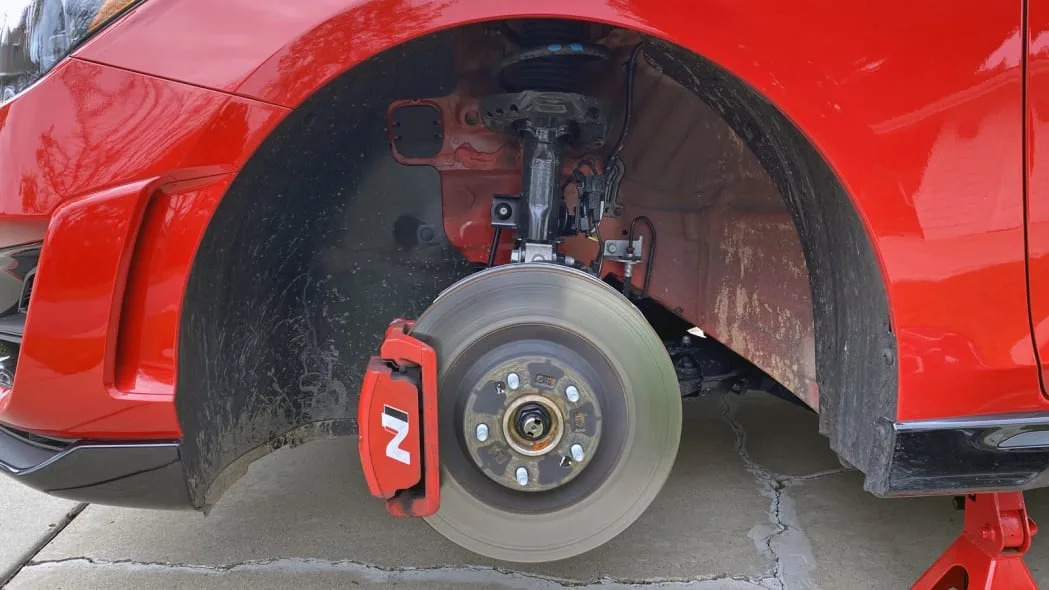
The Veloster and Veloster N both ride on a MacPherson strut front suspension, and here we can see the strut peeking over the top of the brake rotor. There’s something that looks like it’s made of aluminum, too. Always a good sign.

The coil-over strut (yellow arrow) is bolted to an aluminum knuckle (white), which differs from the first-generation Veloster’s use of cast iron for this part. Considering left and right weight savings together, this change is good for a 10.6-pound reduction in unsprung mass.
But the Veloster N isn’t quite the same as the regular 2020 Veloster up here. Many detail changes were worked out during Nurburgring testing sessions, and one of these was a unique knuckle that, along with the tire’s tread width and the wheel’s offset, produced a zero scrub radius. My thin green line approximates the steering axis, and a zero-scrub radius occurs when that line touches the ground in the middle of the tire tread.
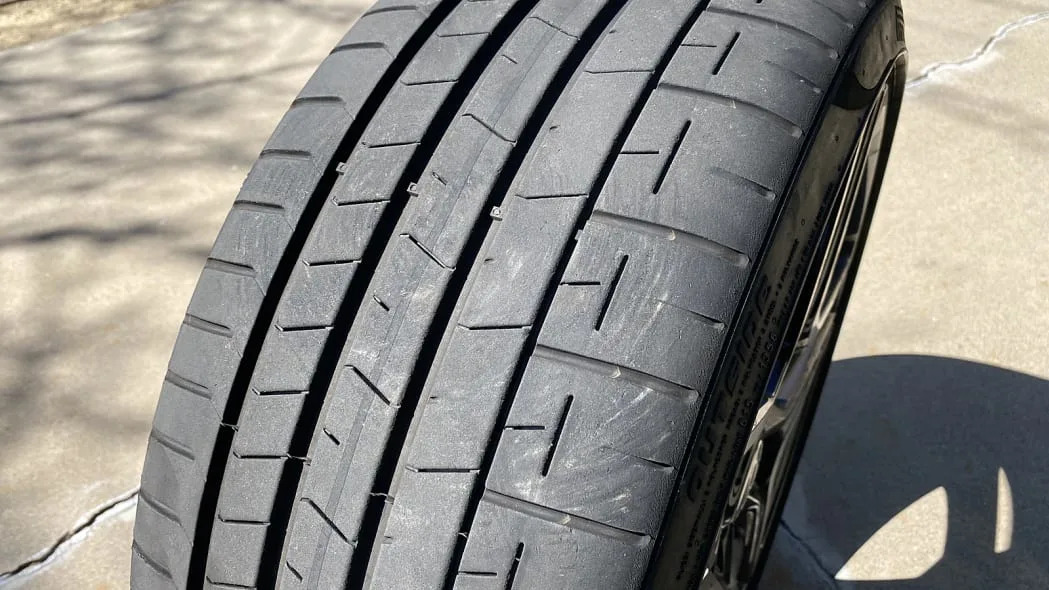
I scrubbed the steering to create these marks before I jacked up the car and got started. They do indeed converge at a point that is close to the center of the tread. It’s hard to pin it down exactly, so don’t worry if the middle looks slightly left of center. Keep in mind that tire sidewalls do roll under and the tread will translate sideways a little during hard cornering. They may be defining zero-scrub while factoring in a certain degree of lateral loading.
Anyway, the stated reasons for doing this have to do with steering precision, quick response and direct on-center feel, and the Veloster N certainly exhibits these traits in good measure. Some suspension designers shy away from zero-scrub because it can create a darty feel, but that could be seen as a feature, not a bug in a performance model like the Veloster N. This could also explain why all Velosters aren’t using zero-scrub steering geometry.
To a certain degree, zero-scrub can keep torque steer within reason. If there’s no scrub radius, the applied driving force at the center of the tire can’t rip the wheel out of your hand — a notable consideration when 270 hp and 265 lb-ft of torque are churning out through the front wheels.
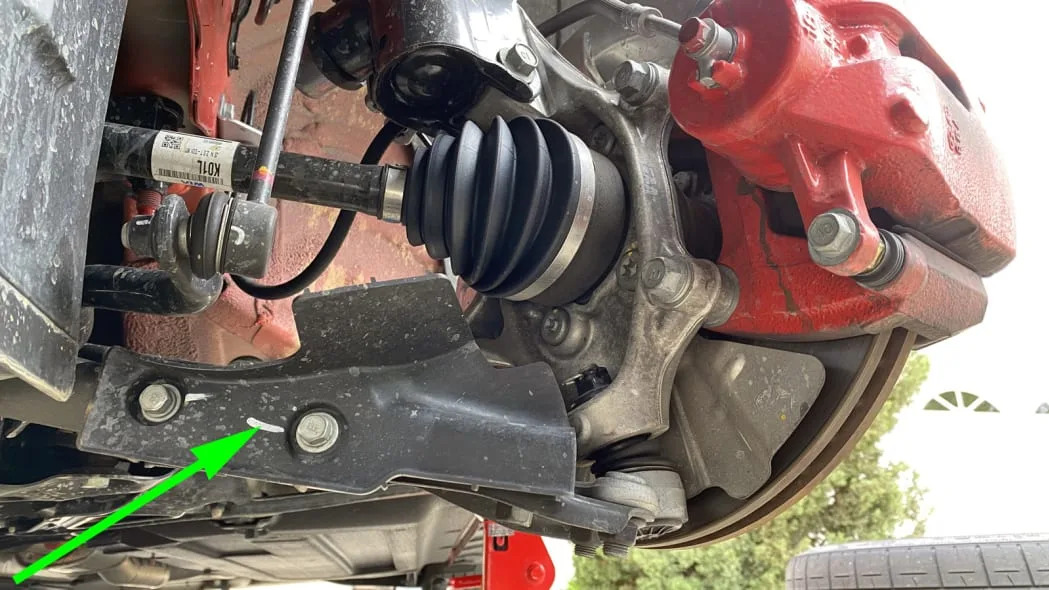
This air deflector (green) shovels air in the general direction of the brake caliper and rotor. It looks like the wheel bearing gets some, too. Say goodbye because it's about to come off.

The lower control arm is an L-shaped steel stamping, and its outer ball joint is easily replaceable via three obvious nuts and bolts. As with many such L-shaped lower arms, lateral cornering loads (white) are handled by the forward bushing, which has a conventional horizontal pivot axis.
Road impacts have two components. The vertical portion goes straight up into the spring and damper, but the rearward jolt (yellow) is taken up as an inward pulse at the rear bushing. This happens because forward bushing doesn’t move fore and aft much and instead acts as a pivot of sorts.

Here you can see how the rear bushing (yellow) is specially shaped. The void allows it to bend up and down despite its vertical bolted joint, but it can also pulse inwards to a controlled degree.
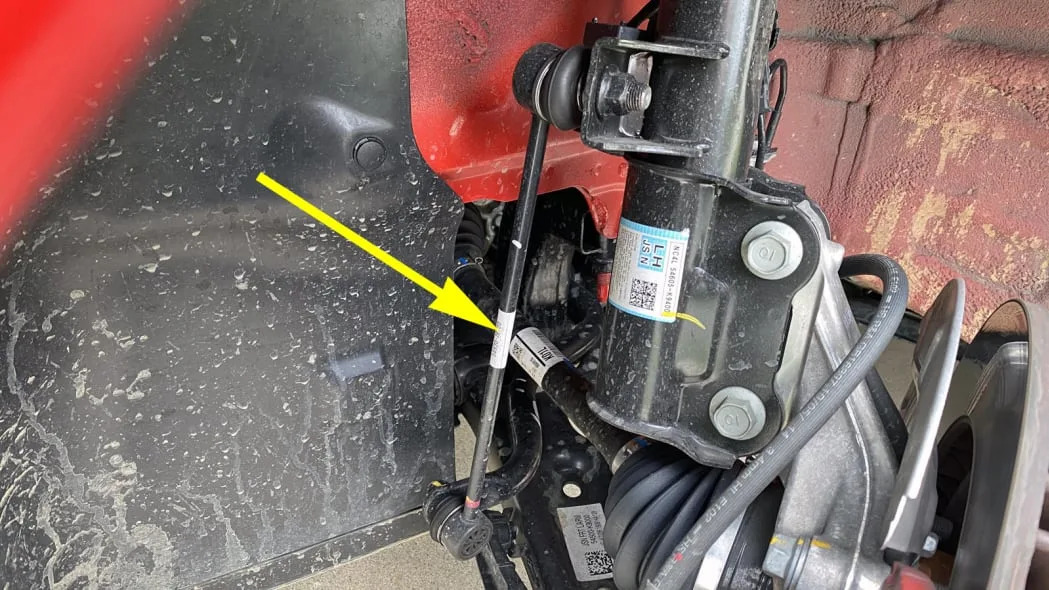
All Velosters use the same direct linkage to the strut itself for a 1-to-1 motion ratio.
Interestingly, the N’s front stabilizer bar is smaller than other versions of the car, which tells me they’re trying to loosen the chassis to make it understeer less. But it’s not that simple, because the N also has other geometry alterations that give it a higher roll center than other Velosters.

It’s no surprise that the Veloster and Veloster N use a steer configuration that places the steering linkage behind the drive axles. The transverse-mounted engine and transmission make it impossible to do it any other way.
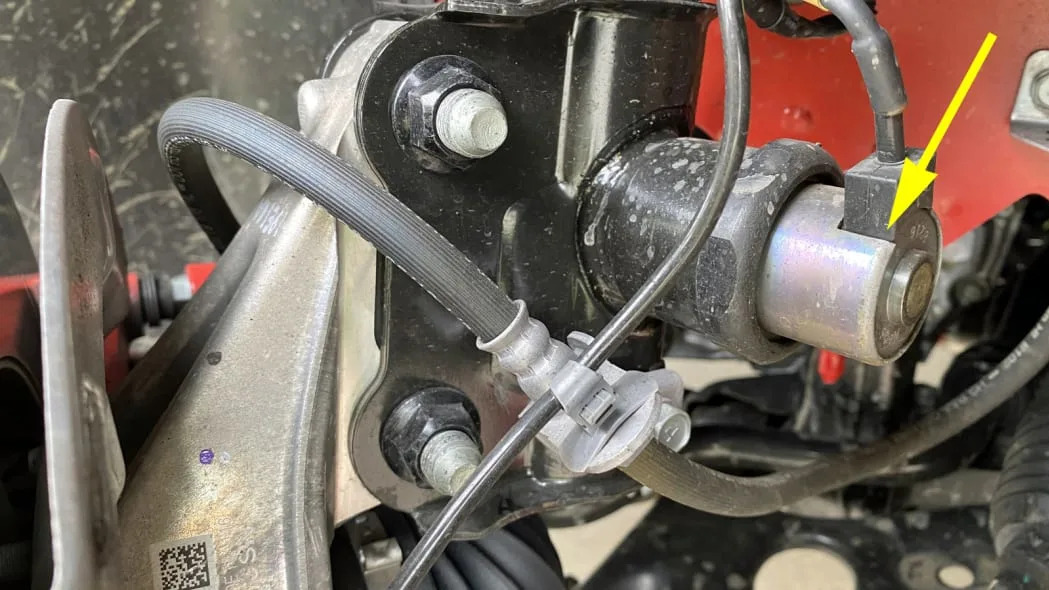
The Veloster N has electronically-controlled dampers that can vary the damping force they produce every hundredth of a second. This actuator controls an external valve that resides just behind it in the same housing. This valve adds damping force above and beyond what’s created by the main working piston inside the damper itself.
There’s a g-sensor elsewhere on the damper, and the system also gets input from the steering angle sensor and body-mounted g-sensors. There are driver-selectable modes, too, that alter the damping character along with steering feel, differential tuning and powertrain response characteristics.

The engine compartment has a built-in cross brace (yellow) that is so close to the firewall that it is easily hidden by plastic trim. A metal ring (white) is there to further stiffen the three-bolt connection point where the upper end of the strut attaches to the body.
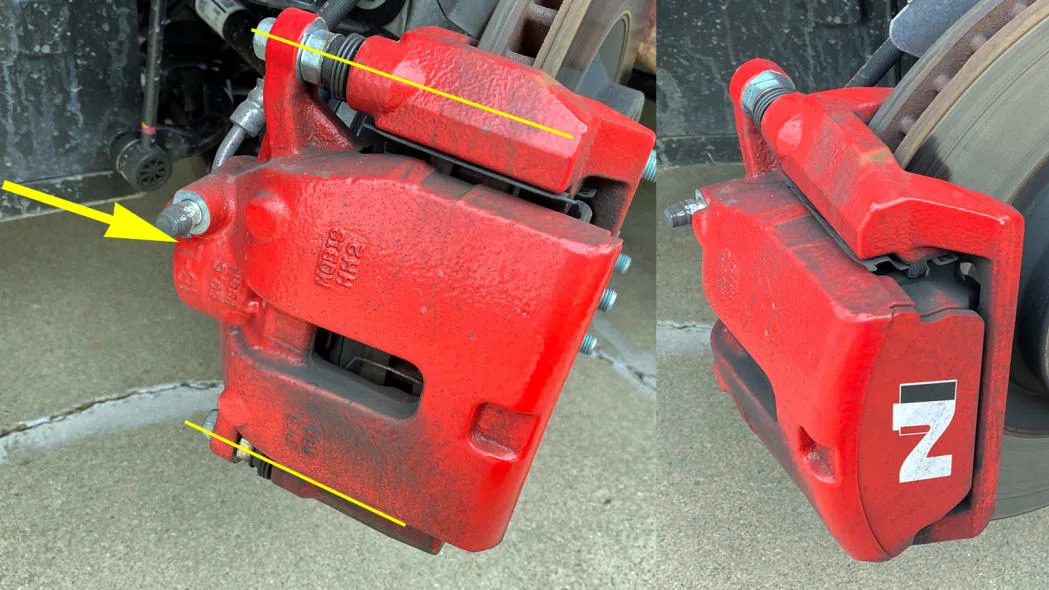
They may be painted Brembo red, but the Veloster N’s brake calipers are simple single-piston (yellow) sliding calipers that are fitted with a smooth trim plate that carries the N logo. There’s nothing wrong with single-piston calipers, especially if they squeeze large rotors with high heat capacity. The Veloster N has 13.6-inch diameter rotors that are 1.2 inches thick.
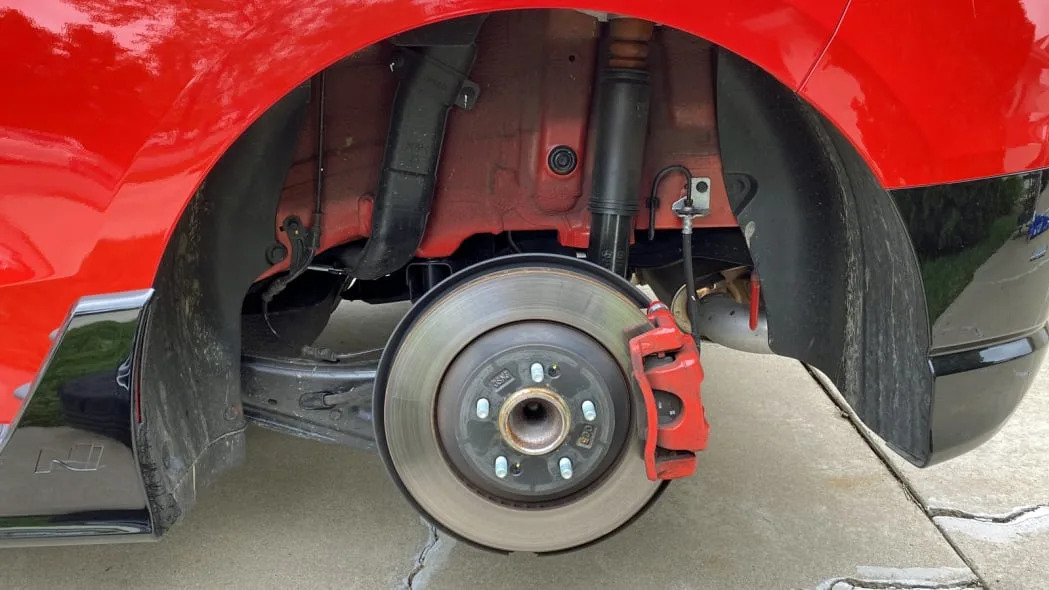
At last we come to the new multilink rear suspension, and already I’m seeing encouraging signs in the form of what looks like a massive trailing arm extending forward to the left of the rotor.
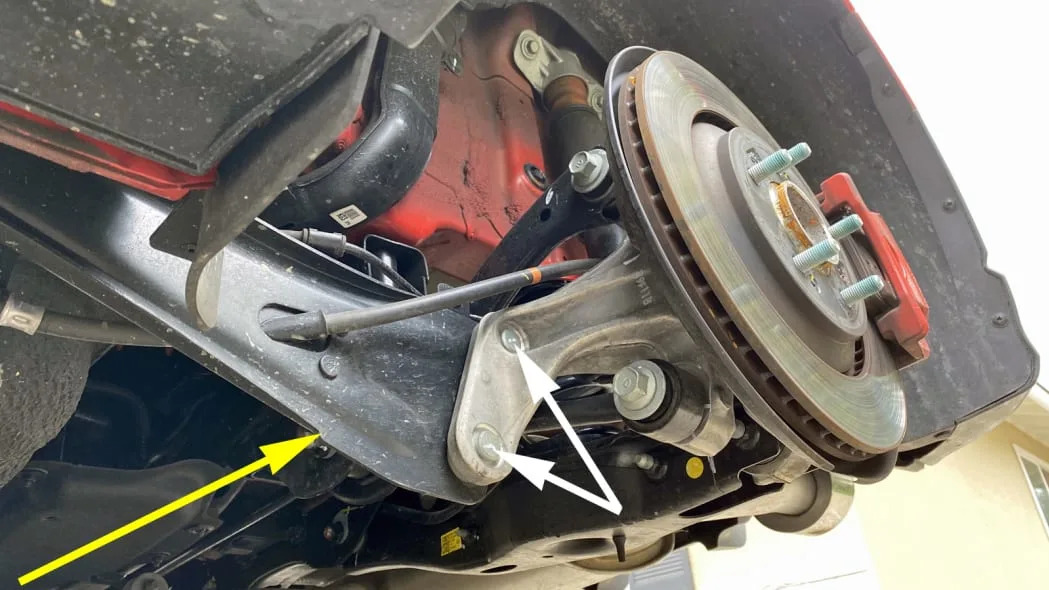
This is indeed a trailing arm (yellow) instead of a trailing link because it has two mounting bolts (white) that connect it firmly to the aluminum knuckle. All by itself, this trailing arm controls the fore-aft position of the wheel and handles all of the torque loads.
Look closer and you’ll see that the folded lip of the arm and the stamped imprint disappears before the bolted joint. We’ll see what that allows in a moment, but these features show this suspension to be similar to the control-blade suspension fitted to the Ford Focus and earlier Mazda 3s. That’s good news because both of those cars not only handled well but managed to do so without delivering a punishing ride.
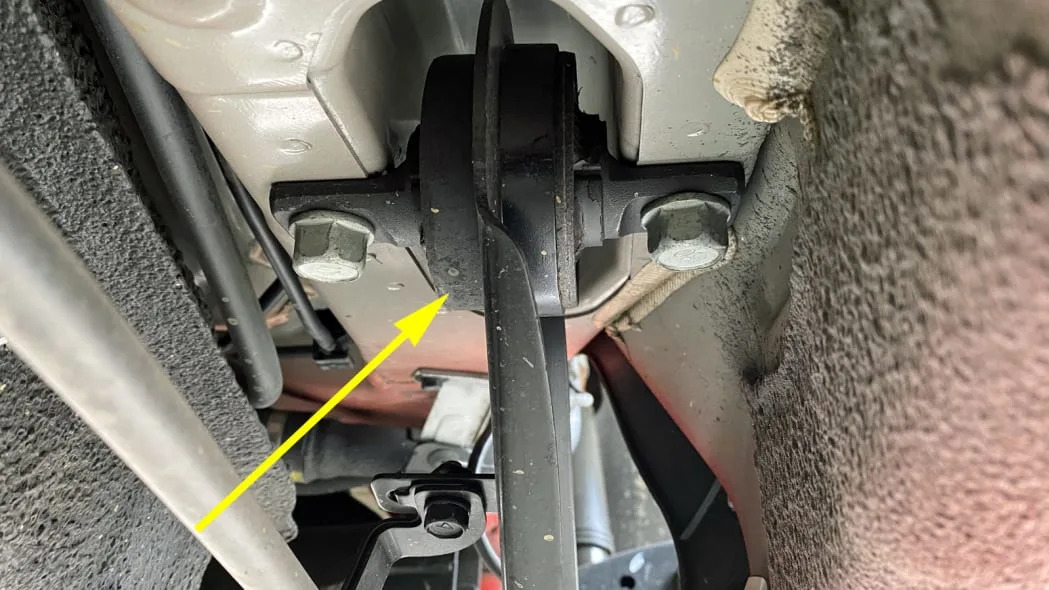
This is the forward mounting point of the blade-style trailing arm, which we may as well refer to as a trailing blade. It’s a high-volume bushing that can absorb the longitudinal component of pothole strikes and large impacts.
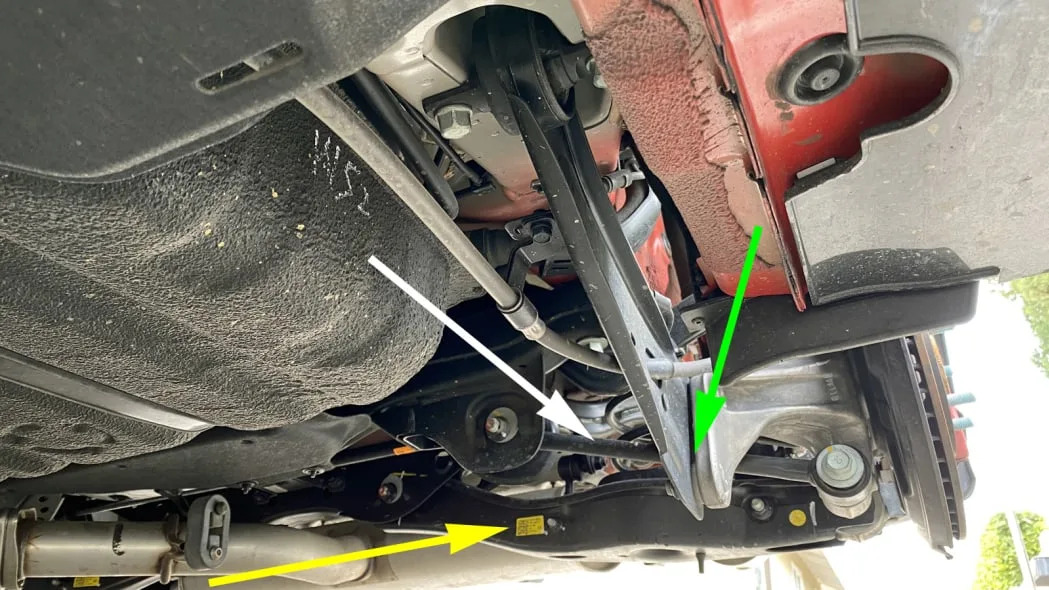
Look closely at the trailing blade’s bolted joint (green) and you’ll notice a bit of a gap. That and the premature end of the blade’s upper and lower flanges means it can flex here just a little.
That’s necessary because of the huge difference in length between the lower lateral link (yellow) and the toe-link (white). This intentional difference creates a measured dose of dynamic toe change that happens as these two links swing through their vastly different arcs. But that change couldn’t happen unless the trailing arm was allowed to flex slightly, which is why we’re seeing these characteristic trailing blade features.
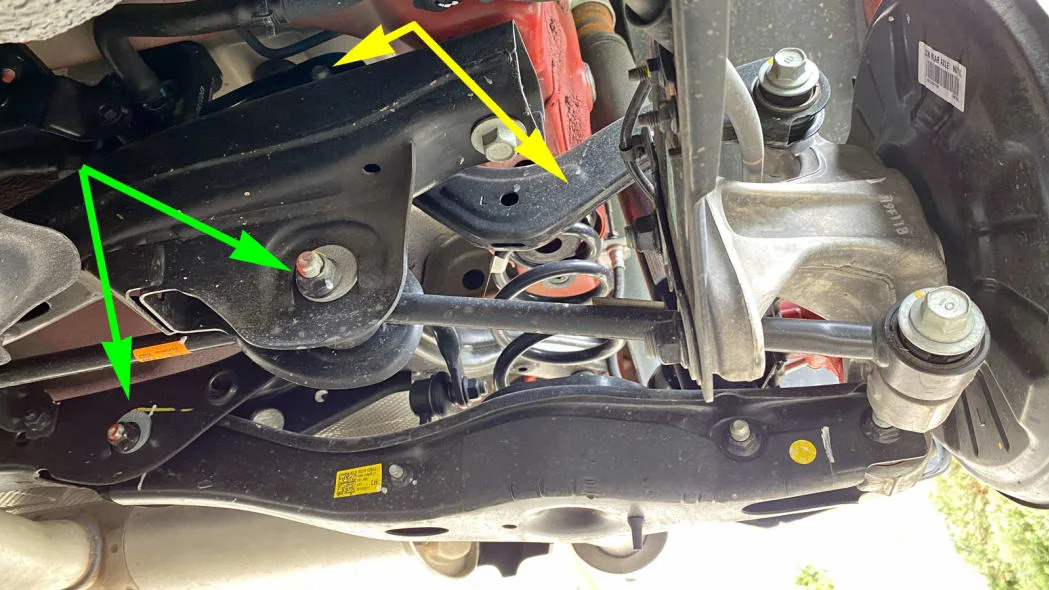
The reason I like the blade-style multilink suspension is that each element has one main task. The lateral links mainly deal with lateral loading, and that makes it easier to optimize their bushings to manage cornering loads. What’s more, only three of them are needed because the blade is handling all fore-aft and torque-management duties.
Because they’re closer to the road, the main lower lateral link and the toe link manage the bulk of the cornering loads. Meanwhile, the upper link (yellow) braces the wheel’s camber angle. This one is typically called a camber link even though in this case camber and toe adjustments are made via eccentrics (green) located at the inner pivots of the lower links.
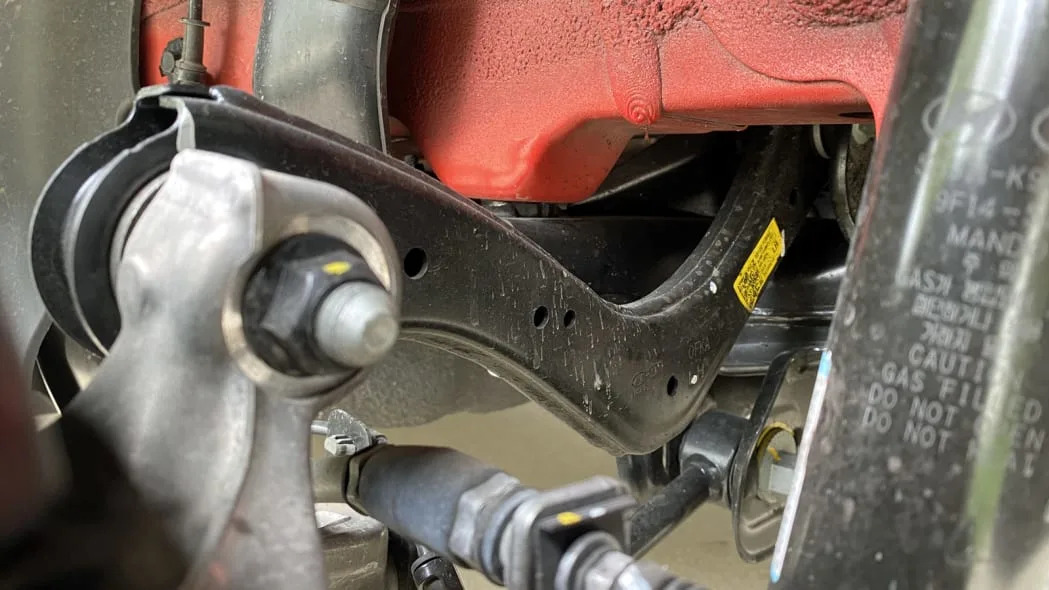
The upper camber link features a distinct curve so it won’t contact the unibody when the suspension compresses despite a high inner pivot point. Despite its shape, the camber link still functions as if a straight shot existed between its two ends.
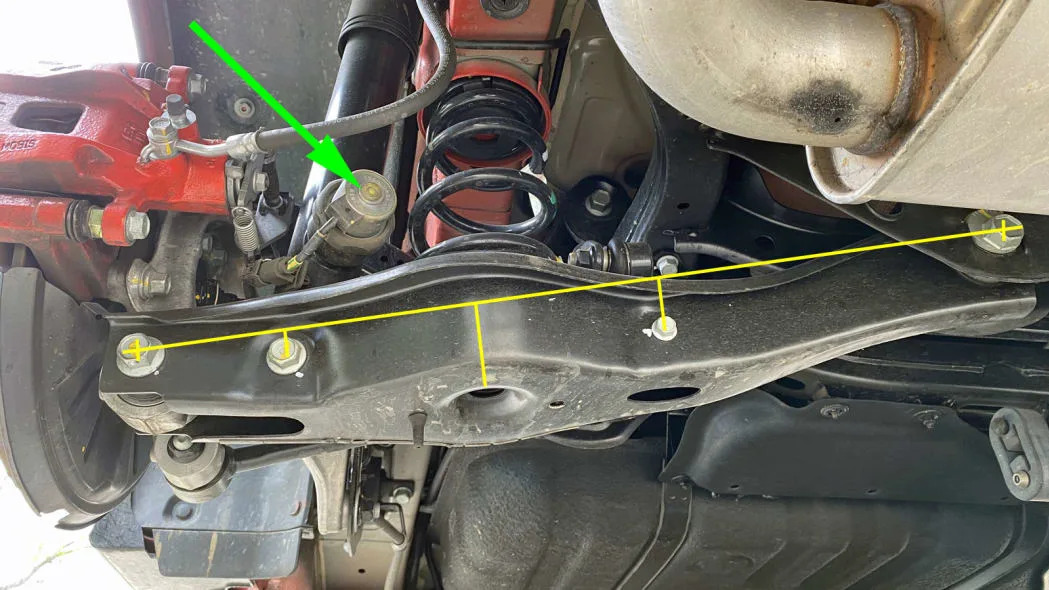
The main lower link earns lower arm status because it is the main mounting point for all of the components that control the vertical movement of the suspension. Outermost of these is the shock absorber, which resides about 85% of the way out from the inner pivot to the knuckle. That gives the shock a 0.85-to-1 motion ratio. This shock, like the front, has an electronically controlled variable damper valve (green).
Inboard of this is the coil spring. Sandwiched between the body and the arm, its motion ratio appears to be about 0.6-to-1 or so. Inboard of that is a small bolt that is the rear stabilizer bar’s attachment point. That looks to be at a motion ratio of 0.4-to-1, possibly more.
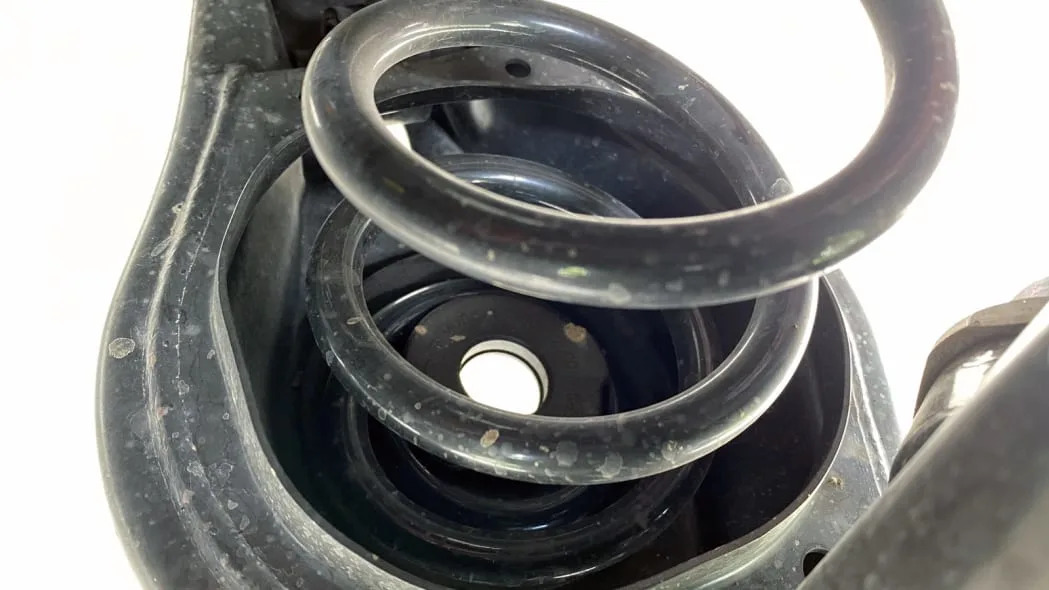
The rear coil spring is a lot longer than it looked in the last image because it rests on the bottom of the lower arm. This fact and the sheer length of the lower arm give the Veloster a healthy amount of suspension rear travel.
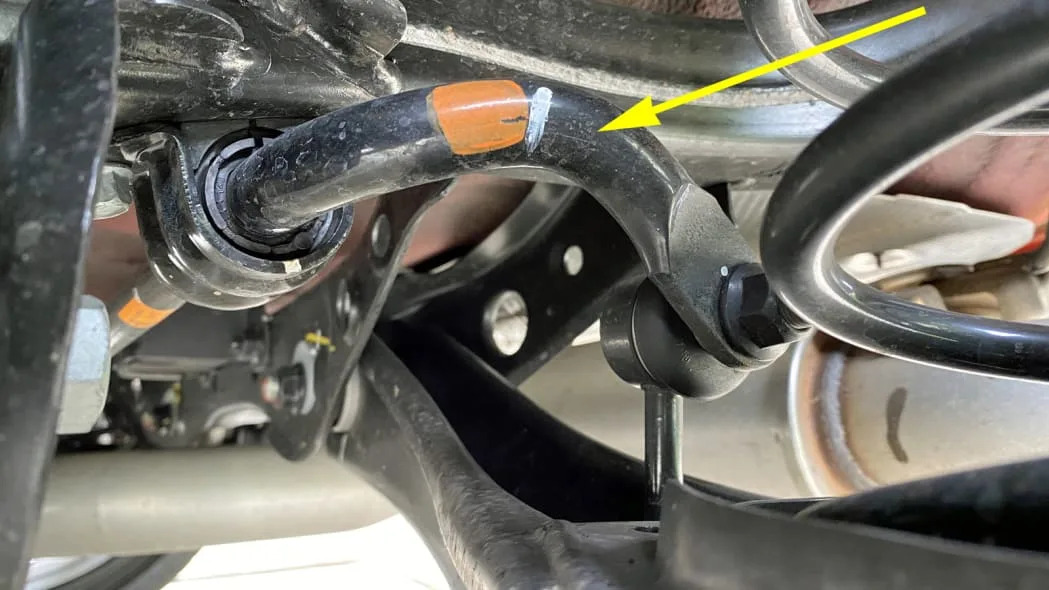
The Veloster’s rear stabilizer bar is compact and tidy. It measures 19 mm here on the N, which is considerably larger than a base Veloster. This would seem to be another sign that this model is tuned to be more “neutrally balanced,” which is how lawyers prefer you say it when you take steps to reduce understeer.
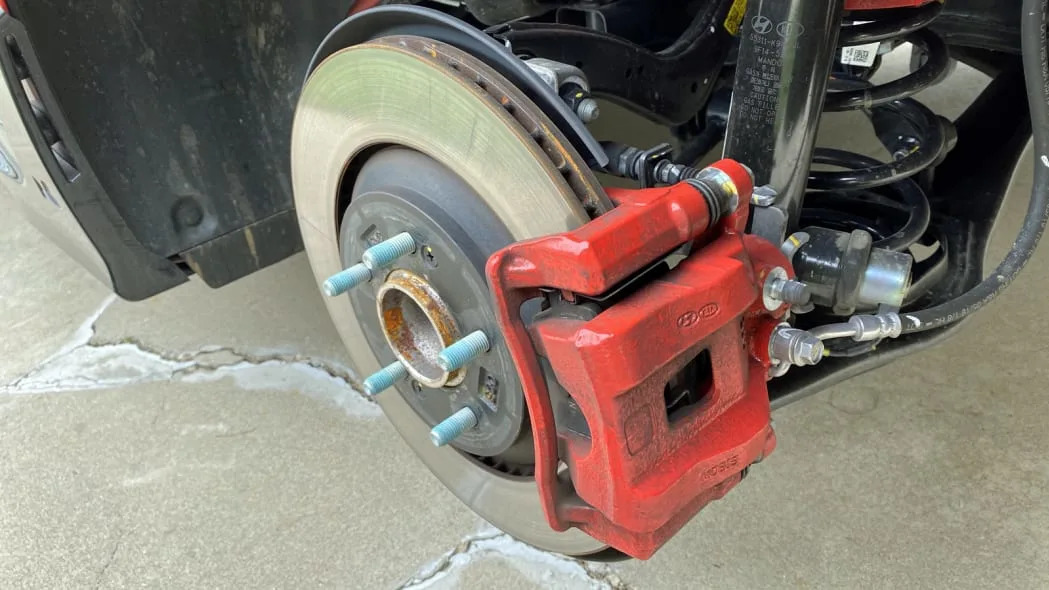
The rear brake uses another red-painted single-piston sliding caliper. The N’s rear rotors are bigger than other models, too: 12.4 inches instead of 11.8 inches. The N’s rear rotors are also the only ones in the Veloster lineup that are ventilated.
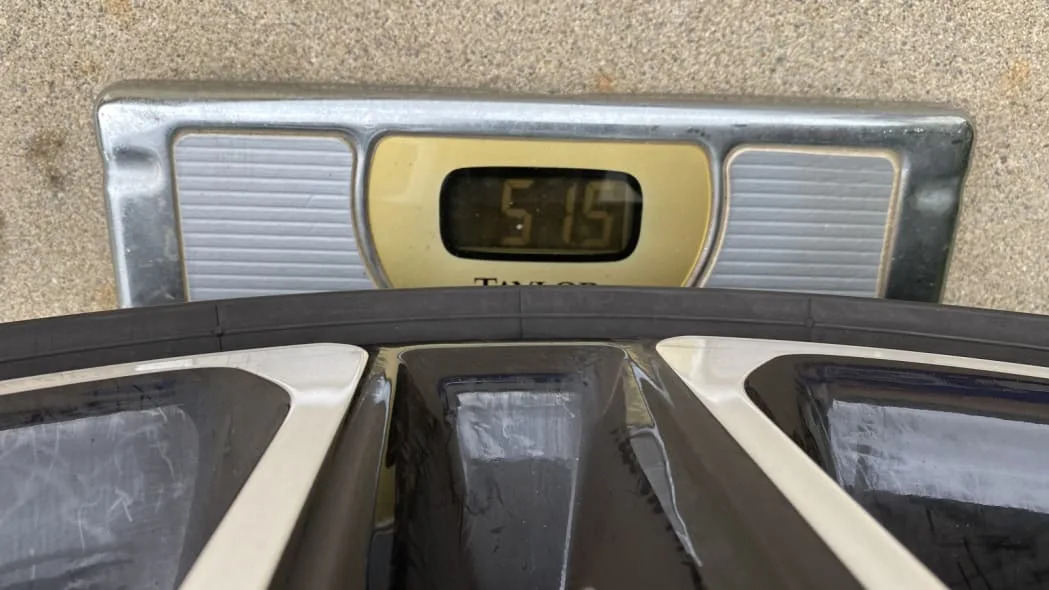
This Veloster N has the optional 19-inch wheel and tires. They’re 235/35R19 Pirelli P-Zero three-season tires, and the assemblies weigh 51.5 pounds. The standard Veloster N fitment consists of 225/40R18 Michelin Pilot SuperSport tires, which are also summer tires.
The end result of all of this is a Veloster I can really sink my teeth into. The N has the power, of course, but it also has a responsive suspension that gives this hot hatch the steering and handling it should have had all along.
Contributing writer Dan Edmunds is a veteran automotive engineer and journalist. He worked as a vehicle development engineer for Toyota and Hyundai with an emphasis on chassis tuning, and was the director of vehicle testing at Edmunds.com (no relation) for 14 years.
Read more Suspension Deep Dives below and let us know which cars you'd like to see Dan put up onto the jack stand next ...
Acura NSX Suspension Deep Dive
Mazda MX-5 Miata Suspension Deep Dive
Toyota GR Supra Suspension Deep Dive
Porsche Taycan Turbo Suspension Deep Dive
Related Video:
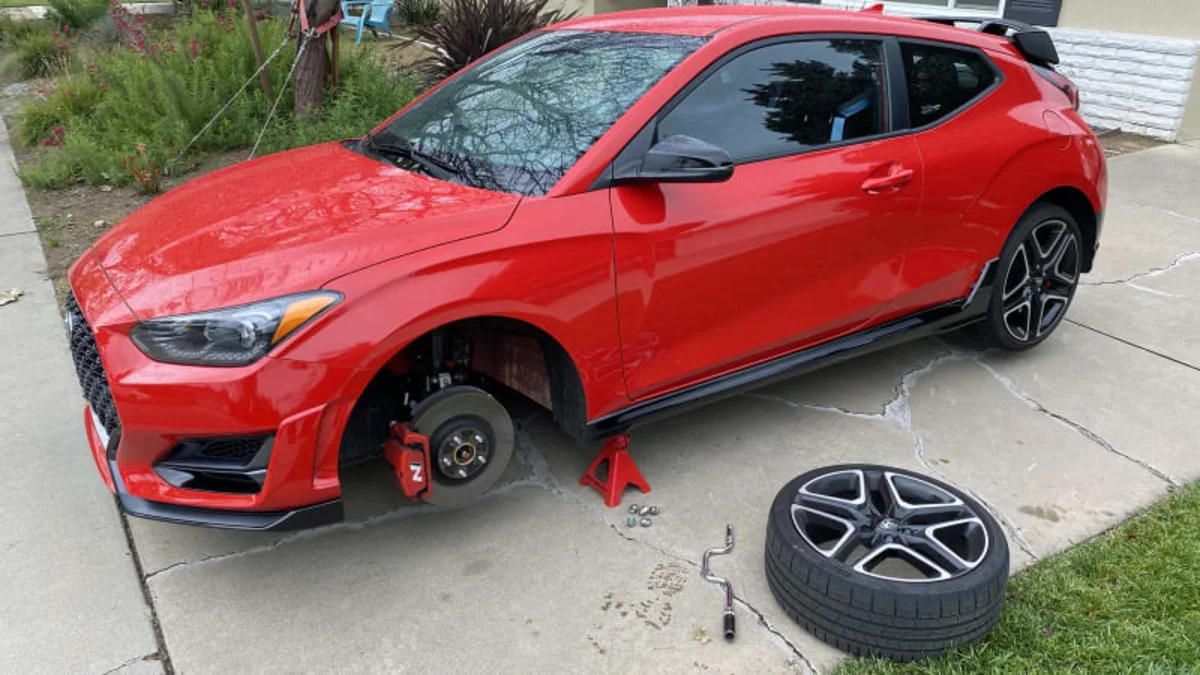


Sign in to post
Please sign in to leave a comment.
Continue